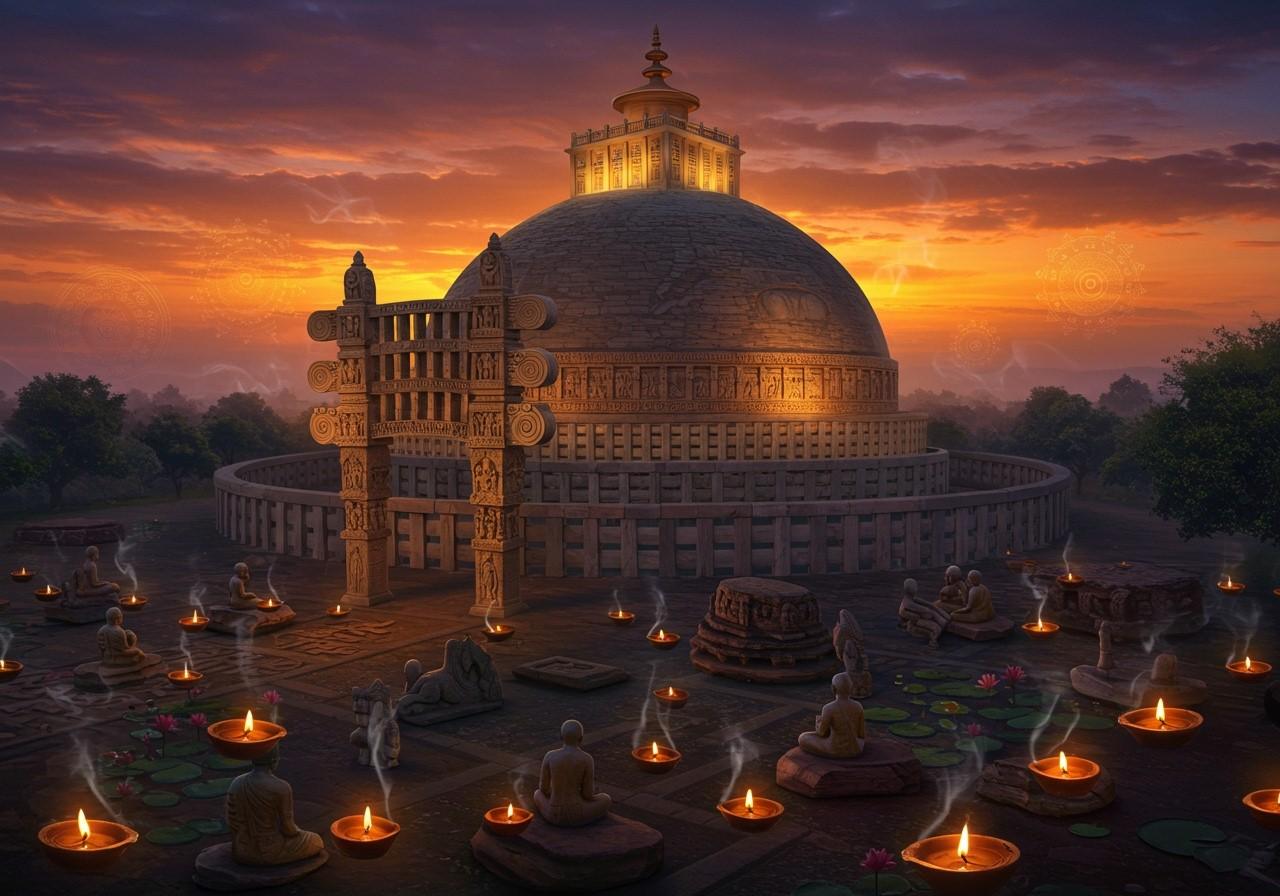
The Sanchi Stupa, nestled in Sanchi Town, Raisen District, Madhya Pradesh, India, is a renowned Buddhist complex. Its centerpiece, the Great Stupa, stands as a testament to India’s rich spiritual and architectural heritage. This ancient marvel, one of India’s oldest stone structures, beckons travelers to explore its intricate carvings, serene ambiance, and the timeless wisdom it embodies.
A Journey Through Time: Historical Background
Emperor Ashoka of the Mauryan Dynasty laid the foundation of the Great Stupa in the 3rd century BCE. Initially a brick structure, it was later encased in stone, a testament to the enduring nature of its spiritual significance. Over the centuries, dynasties like the Shungas, Satavahanas, and Guptas contributed to its embellishment, adding layers of artistry and devotion.
Rediscovered in 1818 by General Taylor, the Sanchi Stupa emerged from the mists of time. The subsequent restoration efforts led by Sir John Marshall in the early 20th century ensured its preservation for generations to come.
An Architectural Masterpiece
The Great Stupa is an architectural marvel, a symphony in stone. Its hemispherical dome (anda) represents the universe, while the square railing (harmika) symbolizes the abode of the gods. The central pillar (yasti) acts as the axis mundi, connecting heaven and earth. Four intricately carved gateways (toranas) adorn the stupa, each aligned with a cardinal direction, narrating stories from Buddha’s life and the Jataka tales.
Crafted from sandstone, the stupa has weathered the passage of time. The Pradakshina patha, a circumambulatory path, invites devotees to walk around the stupa in reverence, a practice imbued with deep spiritual meaning.
Symbolism and Spiritual Significance
The Sanchi Stupa is a repository of profound spiritual symbolism. The dome represents the cosmos, while the yasti symbolizes the connection between the earthly and the divine. Originally housing relics of Buddha, the stupa stands as a sacred site for Buddhists. The toranas, with their elaborate carvings, narrate the life of Buddha and impart moral and spiritual lessons. The lotus flower motifs, recurring throughout the stupa’s design, embody purity and enlightenment.
A Cultural Treasure
Designated a UNESCO World Heritage Site in 1989, the Sanchi Stupa holds immense cultural significance. It serves as a major pilgrimage destination for Buddhists worldwide. The stupa’s unique architectural style has influenced the design of similar structures across Asia, including Sri Lanka, Myanmar, and Thailand. Sanchi stands as a testament to the fusion of diverse cultural and religious influences, reflected in its art and iconography. It also plays a vital role in promoting cultural tourism in India, contributing to the local economy.
Preservation and Endurance
The Sanchi Stupa’s survival through the ages is a testament to its robust construction, strategic location, and the dedication of those who have worked to preserve it. Despite periods of neglect, the stupa has endured, thanks to the efforts of conservationists and the Archaeological Survey of India (ASI). Measures to mitigate environmental factors and the involvement of local communities play a crucial role in safeguarding this cultural treasure.
Sanchi’s Enduring Fame
Sanchi’s fame rests on its historical, architectural, and spiritual significance. The Great Stupa has been instrumental in the dissemination of Buddhist teachings and has inspired Buddhist architecture throughout Asia. Its well-preserved state, intricate carvings, and the serene atmosphere make it a unique destination for both scholars and spiritual seekers. Sanchi fosters intercultural dialogue, symbolizing peaceful coexistence and understanding.
Poojn.in: Your Companion on a Spiritual Journey
Inspired by the spiritual aura of Sanchi? Poojn.in, India’s leading online store for cultural and religious goods, offers a curated collection of items to deepen your connection with Buddhist traditions:
- Prayer Beads (Mala): Discover a diverse range of malas crafted from sandalwood, rudraksha, and other sacred materials, perfect for meditation and chanting practices. These malas are designed to enhance your spiritual experience and connect you with the rich traditions of Buddhism.
- Incense Sticks and Holders: Create a serene ambiance for meditation with our authentic incense sticks and intricately designed holders. Choose from a variety of fragrances and styles to enhance your spiritual practice and create a peaceful atmosphere.
- Meditation Cushions and Mats: Enhance your meditation practice with comfortable and supportive cushions and mats. Our collection offers a variety of options to suit your needs, promoting proper posture and a deeper meditative experience.
Visit Poojn.in today to explore our complete collection and embark on a spiritual journey enriched by authentic and high-quality products.
FAQs: Unraveling the Mysteries of Sanchi
How has the Sanchi Stupa survived for so long? The Sanchi Stupa’s longevity is attributed to its robust construction, using durable materials like sandstone, and the continuous restoration efforts undertaken throughout history. The ASI plays a vital role in its ongoing preservation.
What is the symbolic meaning of the Sanchi Stupa? The stupa embodies the teachings of Buddha, symbolizing enlightenment, the cycle of life and death (samsara), and the path to liberation (Nirvana). It serves as a reminder of Buddha’s presence and the spread of his teachings.
What makes Sanchi so famous? Sanchi’s fame stems from its remarkable ancient Buddhist monuments, especially the Great Stupa, a UNESCO World Heritage Site. Its intricate carvings, imposing gateways, and historical inscriptions attract visitors and scholars from around the globe.
Conclusion: A Timeless Legacy
The Great Stupa at Sanchi stands as a timeless symbol of India’s rich cultural and spiritual heritage. Its enduring presence continues to inspire awe and reverence in those who visit. The stupa is not merely an architectural wonder; it is a testament to the power of faith, resilience, and the pursuit of enlightenment. As we explore its legacy, we connect with the wisdom of the past and embrace the enduring message of peace and harmony that it represents.


